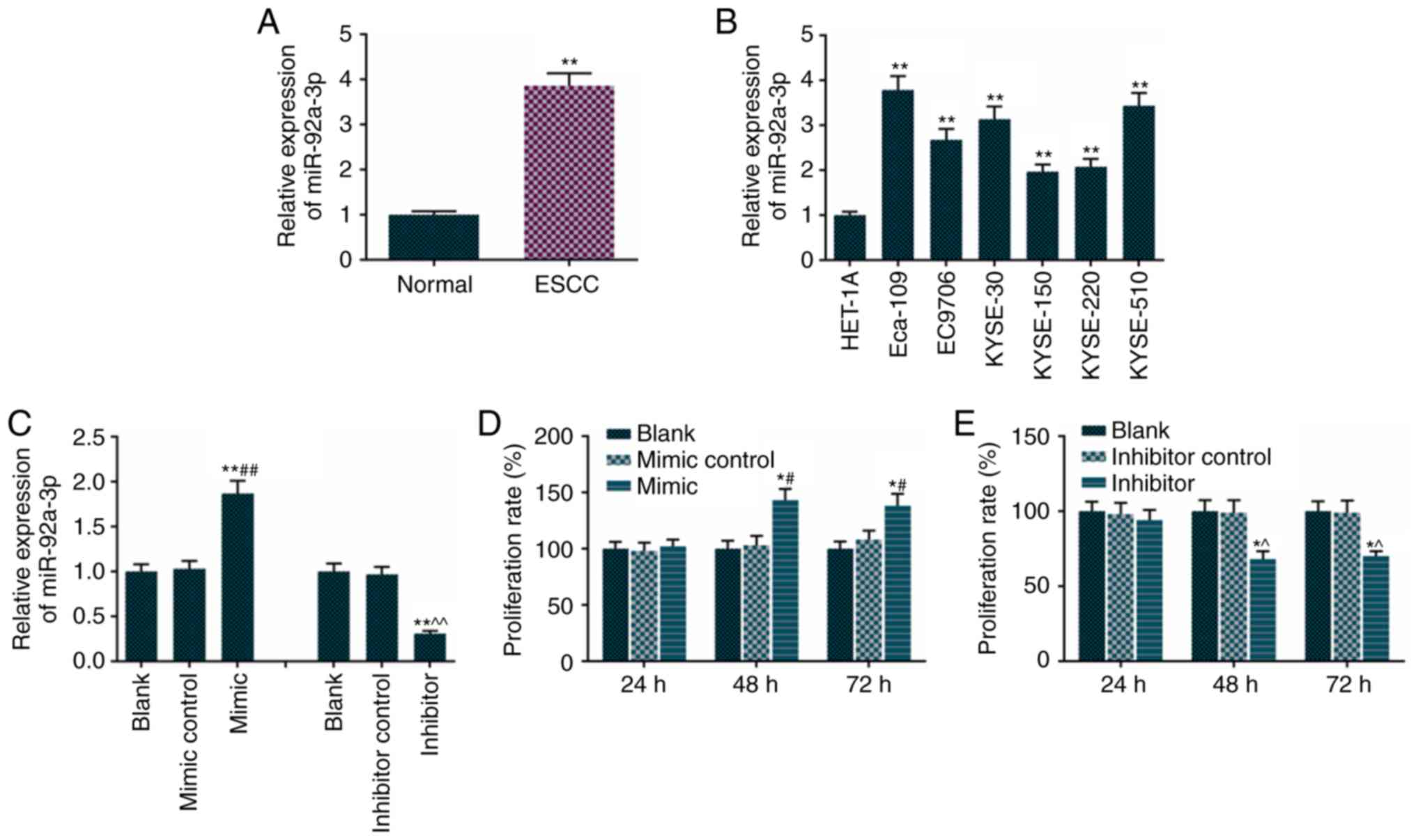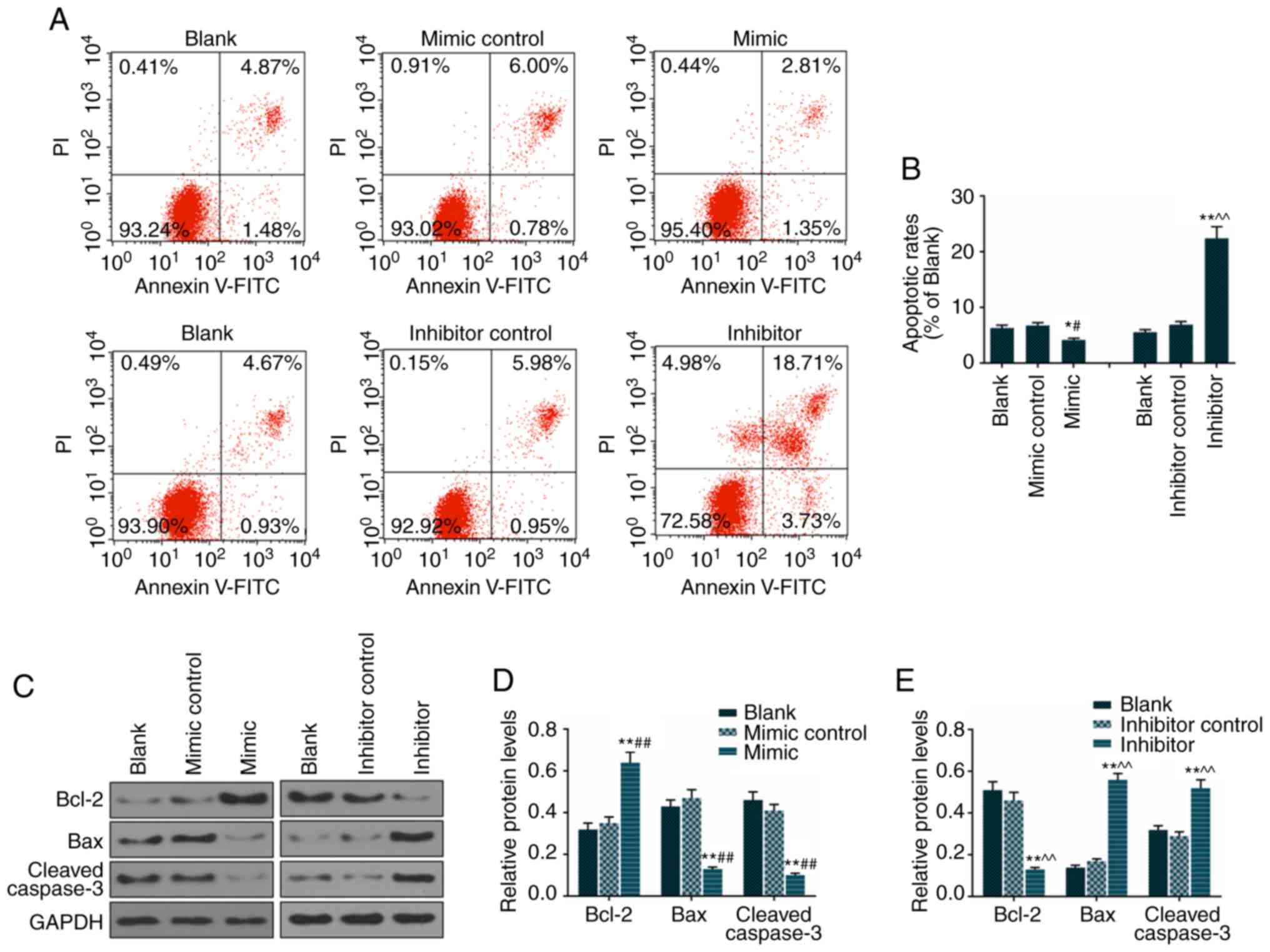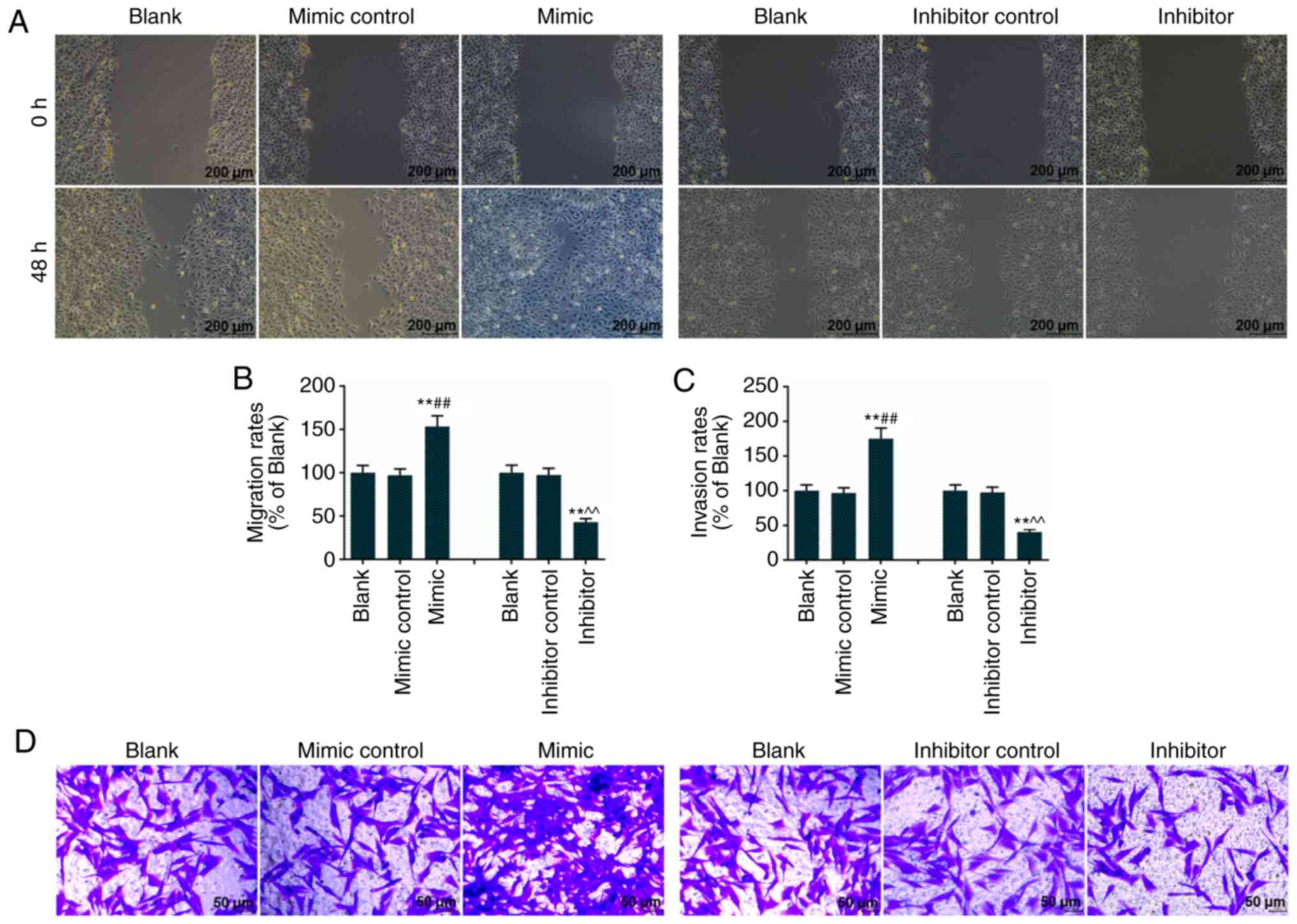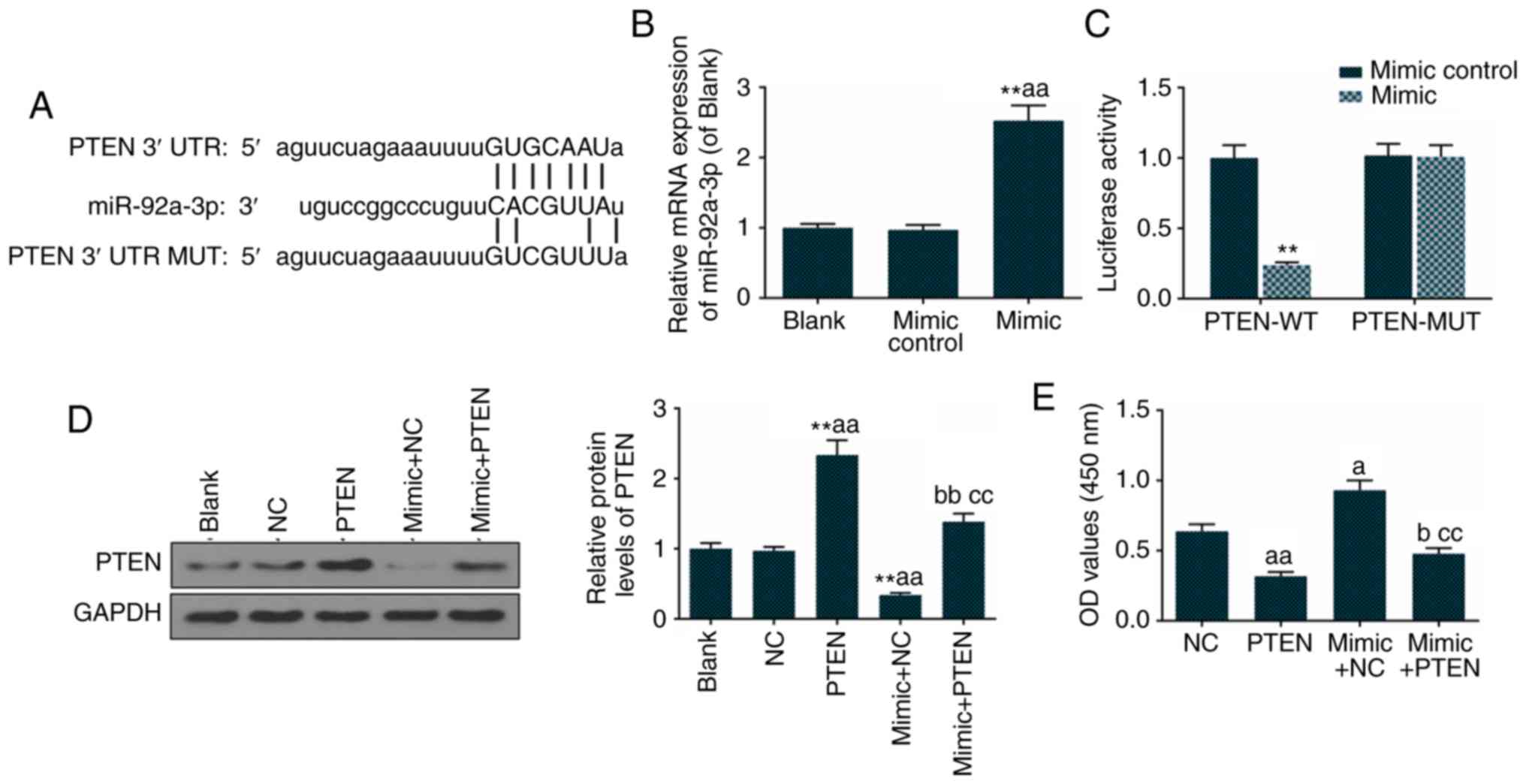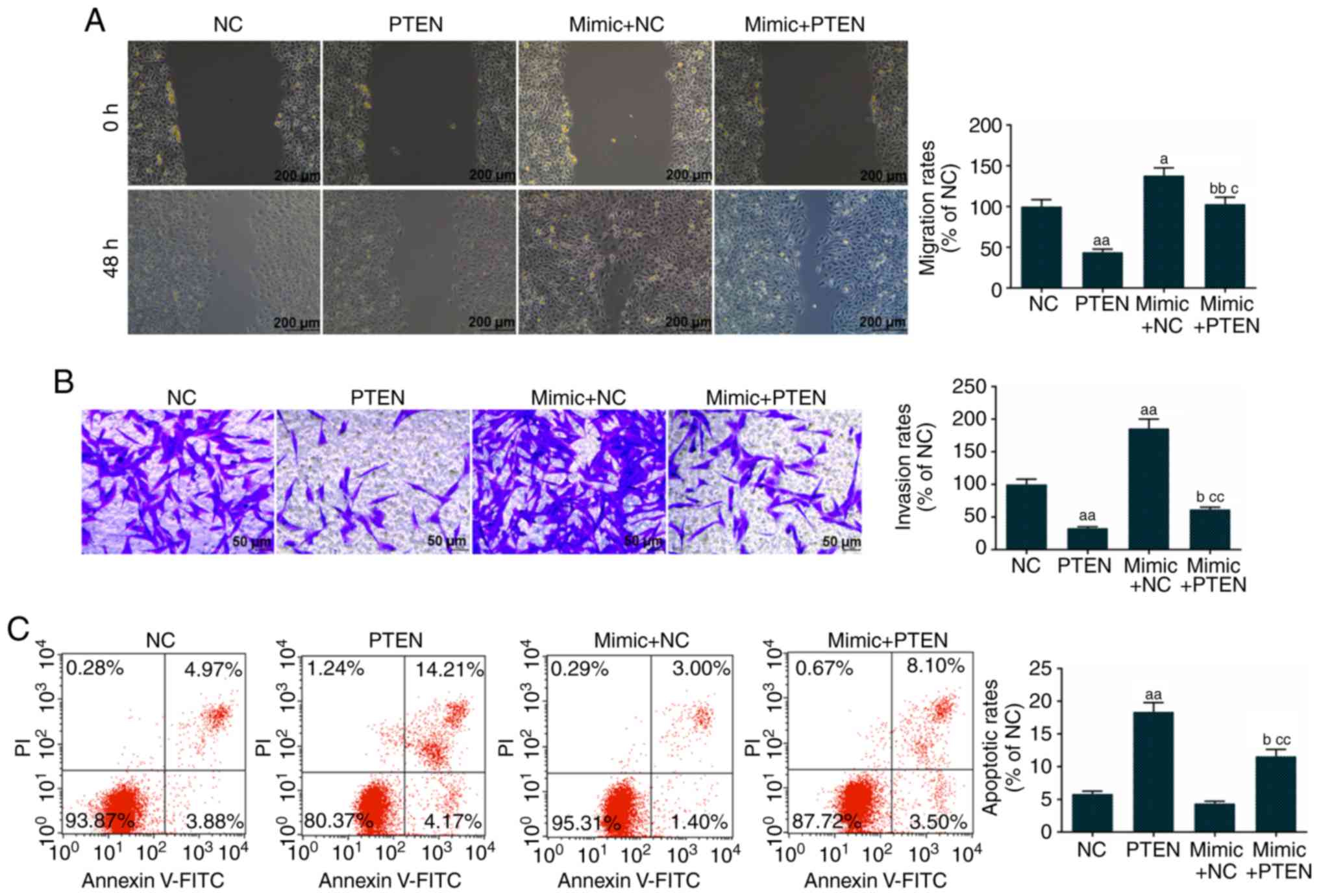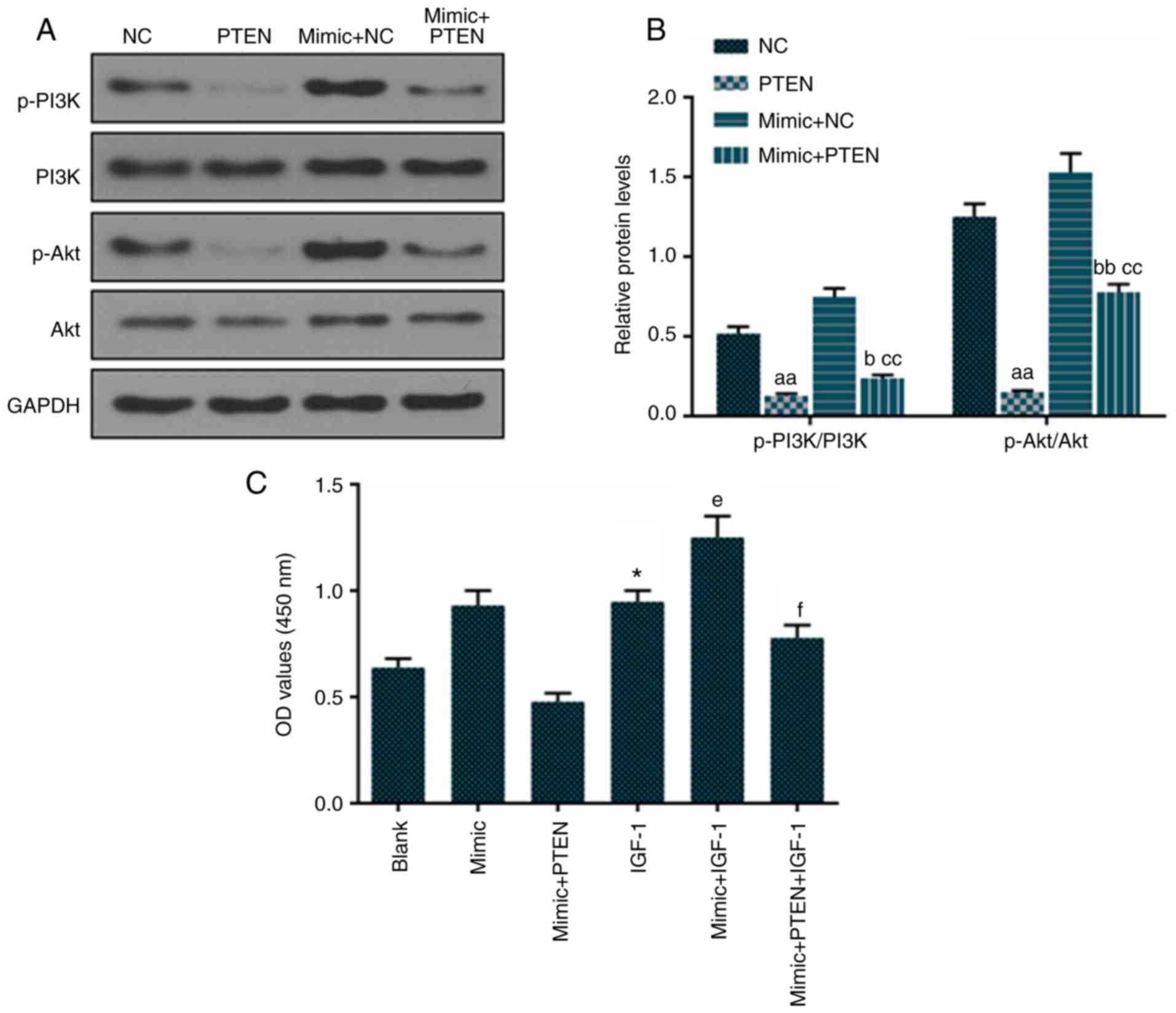miR-92a-3p promotes the proliferation, migration and invasion of esophageal squamous cell cancer by regulating PTEN
- Authors:
- Published online on: June 27, 2019 https://doi.org/10.3892/ijmm.2019.4258
- Pages: 973-981
-
Copyright: © Li et al. This is an open access article distributed under the terms of Creative Commons Attribution License.
Abstract
Introduction
Esophageal cancer (EC) is the eighth most frequent type of cancer in the world and has a poor prognosis due to its aggressiveness and poor survival rate. In 2003, >90% of cases of EC were esophageal squamous cell cancer (ESCC) and esophageal adenocarcinoma (ECA), and this proportion increased to 95% in 2017 (1,2). In patients with ECA, the nidus is usually found in the distal esophagus, whereas the nidus in patients with ESCC is more commonly distributed between the middle and lower third of the esophagus (3,4). ESCC is more frequent in developing countries, and risk factors, including achalasia, smoking and alcohol use, are common to ESCC (2). In terms of the clinical cT category, ~20% patients with stage cT4a ESCC have a survival time of 10 years, and <30% patients have a survival time of 5 years (5). CDKN2A hypermethylation, which is frequent in patients with ESCC, accounts for 40-62% of cases, however, there is lack of valid evidence to confirm methylated CDKN2A as a biomarker for ESCC (6).
MicroRNAs (miRNAs) are ~22 nt in length, and they fall complementally in the 3′ untranslated region (3′UTR) in target mRNAs, therefore, they have a critical function in animals and plants (7). It has been reported that >60% of human protein-coding genes are regulated by miRNAs, and miRNAs originating from the diet or endogenous synthesis are involved in physiology and pathology, including inflammation and cancer (8,9). miRNAs can be upregulated or downregulated in tumor tissues compared with normal tissues, and they can be divided into tumor promoter and tumor suppressor miRNAs (10). miRNA (miR)-15/16, miR-34 and the miR-200 family are reported to have inhibitory effects on lung cancer; the overexpression of miR-15/16 inhibited non-small cell lung cancer cell proliferation and invasion by regulating TWIST1 (10,11); miR-17-92, miR-222/221 and miR-155 were found to promote the progression of breast cancer, and miR-17-5p promoted breast cancer cell invasion and migration through the inhibition of HMG box-containing protein 1 (10,12).
The miR-17-92 cluster is composed of six miRNAs (miR-17, miR-18a, miR-19a, miR-19b, miR-20a and miR-92a-3p) and is located on chr13q31.3 within the third intron of the C13orf25/MIR17HG gene (13). miR-92a-3p is considered as a tumor promotor, and a previous study reported that miR-92a-3p acted as an oncomiR in colorectal cancer cells via regulating the phosphatase and tensin homolog deleted on chromosome 10 (PTEN)-mediated PI3K/AKT pathway (14). The serum levels of miR-92a-3p were reported to be associated with ESCC (15). Therefore, miR-92a-3p was considered a miRNA of interest and PTEN was considered a target mRNA of interest in ESCC in the present study. The transfer of miR-93-5p by exosomes promotes the proliferation of EC cells via intercellular communication by targeting PTEN (16). PTEN has been reported to be associated with tumors, including esophageal tumors. A novel heterozygous mutation in the PTEN gene was reported to be associated with an ovarian germ cell tumor complicated by growing teratoma syndrome and overgrowth in a two-year-old female (17). The fibroblast growth factor receptor 2-mediated phosphorylation of PTEN at tyrosine 240 contributes to the radioresistance of glioma (18). miR-21 suppresses anoikis through targeting PTEN in human esophageal adenocarcinoma (19). Therefore, PTEN may be regulated differently in EC. However, whether miR-92a-3p regulates PTEN in ESCC remains unknown.
To investigate the role of the downregulation of PTEN, it was hypothesized in the present study that miR-92a-3p targeted PTEN to exert effects on the progression of ESCC. As the modulation of miRNAs can be realized by miRNA mimics and miRNA antagonists (20), the present study used the miR-92a-3p mimic and miR-92a-3p inhibitor to investigate the effect of miR-92a-3p on ESCC, according to cell proliferation, migration and invasion, and examine effects of the target gene of miR-92a-3p on ESCC cell proliferation, migration, invasion and survival pathways. This study may provide a better understanding of the mechanism underlying the occurrence of ESCC.
Materials and methods
Reverse transcription-quantitative polymerase chain reaction (RT-qPCR) analysis
The samples used in the present study consisted of 23 EC tissues and adjacent tissues, which were collected from patients with ESCC (14 males and 9 females, 43-65 years old) from Shanxi Provincial People's Hospital, the HET-1A cell line (normal esophageal cell line) and ESCC cell lines between 2016 and 2017. The patients signed an informed consent form and the study was approved by the Ethics Committee of Shanxi Provincial People's Hospital (no. SP2016064926). RNAs were extracted from samples with TRIzol (Invitrogen; Thermo Fisher Scientific, Inc., Waltham, MA, USA) by centrifugation (Cence, Changsha, Hunan, China) at 8,000 × g for 10 min at 4°C. The concentration of RNA was determined using a Multiskan reader (Thermo Scientific, Waltham, MA, USA) at a wavelength of 260 nm. A cDNA kit (Applied Biosystems; Thermo Fisher Scientific, Inc.) was used to synthesize cDNA from the RNA substrate, according to the manufacturer's instructions.
The deoxyribonucleotide primers, which were synthesized by Sangon Biotech (Shanghai, China), used in the PCR are listed in Table I. qPCR was performed under the following conditions: Initial denaturation at 95°C for 90 sec, 45 cycles of denaturation at 95°C for 30 sec, annealing at 50°C for 60 sec, extension at 72°C for 35 sec and a final extension at 72°C for 10 min. The 2−∆∆Cq method (21) was used to analyze relative mRNA.
Cell culture and cell transfection
HET-1A cells originate from the human esophagus and were purchased from the Cancer Institute, Chinese Academy of Medical Sciences (CICAMS; Beijing, China). The ESCC cell lines (Eca-109, EC9706, KYSE-30, KYSE-150 and KYSE-220) and KYSE-510 cell line originate from the esophagus of patients with ESCC and were purchased from CICAMS. All cells were cultured with RPMI-1640 medium (Gibco; Thermo Fisher Scientific, Inc.) containing 10% fetal bovine serum (Gibco; Thermo Fisher Scientific, Inc.) and 1% 10,000 U/ml penicillin-10,000 µg/ml streptomycin (Gibco; Thermo Fisher Scientific, Inc.) at 37°C with 5% CO2 in an incubator (Thermo Fisher Scientific, Inc.). The cells (5×105) were inoculated into each well of 96-well plates. The miR-92a-3p mimic, miR-92a-3p inhibitor, mimic control, inhibitor control, pcDNA3.1 plasmid and PTEN-pcDNA3.1 overexpression plasmid were synthesized by Guangzhou RiboBio Co., Ltd. (Guangzhou, China). Depending on the group, 1 µg PTEN-pcDNA3.1 overexpression plasmid (PTEN group) or pcDNA3.1 plasmid (NC group), 0.25 µg mimics (mimic group) or inhibitor (inhibitor group) or mimics control (mimic control group) or inhibitor control (inhibitor control group) were mixed (2:1) with 1 µl lipofectamine (Invitrogen; Thermo Fisher Scientific, Inc.) and free-FBS RPMI-1640 medium, and the mixed solution was used to treat the cells for 4 h in an incubator at 37°C. Subsequently, the culture medium was replaced by the mixed solution to culture the cells. Cells without any treatment were used as a blank control (Blank group). The sequence were as follows: Mimic, 3′-UGU CCG GCC CUG UUC ACG UUA U-5′; inhibitor, 3′-ACA GGC CGG GAC AAG UGC AAU A-5′; mimic control, 5′-UUU GUA CUA CAC AAA AGU ACU G-3′; inhibitor control, 5′-CAG UAC UUU UGU GUA GUA CAA A-3′.
Cell apoptosis and proliferation assays
To analyze apoptosis, the cells (5×103 cells/well) were added into a 96-well plate. Insulin-like growth factor 1 (IGF-1) was purchased from Bersee (Beijing, China). The cells were resuspended with phosphate-buffered saline (PBS; Gibco; Thermo Fisher Scientific, Inc.). Cell apoptosis were detected using Annexin V FITC (5 µl) and propidium iodide (PI, 5 µl) for 5 min at 37°C and analyzed using flow cytometry (Invitrogen; Thermo Fisher Scientific, Inc.) and the machine system. The experimental protocol was conducted following the manufacturer's instructions.
For the proliferation assay, the cells were seeded into a 96-well plate (Corning Incorporated, Corning, NY, USA) for 24 h, following which the reagents were used to treat the cells for 48 h. A cell counting kit-8 (CCK-8; Sigma-Aldrich; Merck KGaA, Darmstadt, Germany) was diluted with free-FBS RPMI-1640 medium at a ratio of 1:9 and added to the cells and for 1 h in an incubator. A Multiskan reader was used to determine the absorbance at a wavelength of 450 nm.
Cell invasion and migration assays
Matrigel (100 µl; Sigma-Aldrich; Merck KGaA) was diluted in free-FBS RPMI-1640 medium at a ratio of 1:8 and added to the Transwell chamber (Corning Incorporated) in an incubator for 6 h at 37°C to ensure solidification of the Matrigel. The cells (1×106/ml) were resuspended with free-FBS RPMI-1640 medium and were then added in top chamber of the Transwell following treatment with the reagents for 48 h, and 20% FBS RPMI-1640 medium was added to lower chamber of the Transwell. The Transwell containing the cells was placed in an incubator at 37°C for 24 h. A methanol:acetone (1:1) solution (Beijing Solarbio Science & Technology Co., Ltd., Beijing, China) was used to fix the cells, and 4% crystal violet solution (Beijing Solarbio Science & Technology Co., Ltd.) was used to stain the invaded cells. Images were captured using Olympus DSX100 optical microscope (Olympus Corporation, Tokyo, Japan).
The reagents were used to treat the cells for 48 h, following which the cells were resuspended in 2% FBS culture medium. The cells were added to a 35-mm dish, and a 200 µl pipette tip (Sigma-Aldrich; Merck KGaA) was used to scratch the cells. After 48 h, images of the scratches were captured using a microscope. The shortened distances of the scratches were used to determine the migration rates.
Western blot analysis
Total protein was extracted from the cells using lysis solution (Invitrogen; Thermo Fisher Scientific, Inc.). The protein concentration was determined with a BCA kit using a Multiskan reader (Thermo Fisher Scientific, Inc.) at a wavelength of 562 nm. The prestained protein ladder (Invitrogen, Carlsbad, CA, USA) and protein samples (10 µg/lane) were separated by SDS-PAGE on a 12% gel and were then transferred onto PVDF membranes (Sigma-Aldrich; Merck KGaA) by cataphoresis. The protein membranes were then stained with 1X ponceau solution (Beijing Solarbio Science & Technology Co., Ltd.) and the blank spot of the membranes were blocked by 5% bovine serum albumin solution (Beijing Solarbio Science & Technology Co., Ltd.). Primary antibodies were used to incubate the protein membranes for 12 h at 4°C. The primary antibodies, from Abcam (Cambridge, MA, USA), were as follows: Bcl-2 (cat. no. ab59348; 26 kDa), Bax (cat. no. ab32503; 21 kDa), cleaved caspase-3 (cat. no. ab2302; 17 kDa), PTEN (cat. no. ab32199; 54 kDa), phosphorylated (p-)PI3K (cat. no. ab182651; 84 kDa), PI3K (cat. no. ab191606; 85 kDa), p-Akt (cat. no. ab38449; 56 kDa), Akt (cat. no. ab8805; 55 kDa; all 1:1,000) and GAPDH (cat. no. ab8245; 36 kDa; 1:2,000). Secondary antibodies (cat. no. ab6721; 1:5,000; Abcam) were used to incubate the protein membranes for 2 h at room temperature. The protein membranes were stained using an ECL kit (Sigma-Aldrich; Merck KGaA), and fluorescence was determined using an imaging system (Tanon Science and Technology Co., Ltd., Shanghai, China) and protein stains were analyzed using the BandScan 5.0 system (Glyko, Inc., Novato, CA, USA).
Dual luciferase reporter assay
TargetScan 7.0 (www.targetscan.org) was used to predict the miR-92a-3p target and its related sites. 293T cells (American Type Culture Collection) were plated onto 12-well plates (5×105 cells/well) prior to cell transfection. Subsequently, either the PTEN 3′UTR wild-type or PTEN 3′UTR mutant was cloned into the psi-CHECK-2 vector (Promega Corporation, Madison, WI, USA). The full length of PTEN 3′UTR was 5′-AGU UCU AGA AAU UUU GUG CAA UA-3′. Subsequently, pGL-3 firefly luciferase reporters (1 µg per well) were co-transfected with 50 nmol/l universal mimics control (mimic control) or miR-92a-3p mimics and PTEN 3′UTR wild-type or PTEN 3′UTR mutant using Lipofectamine 2000 reagent (Invitrogen; Thermo Fisher Scientific, Inc.), according to the manufacturer's protocol. The cells transfected with mimics control and PTEN 3′UTR wild-type were used as a control. Luciferase activity was determined using a dual-luciferase reporter assay kit (Promega Corporation).
Statistical analysis
For all experiments, three trials were performed in triplicate. All values are expressed as the mean ± SD. The differences between two groups were analyzed using Student's t-test, or one-way ANOVA followed by Dunnett's t-test or Tukey post hoc test using SPSS 22.0 (IBM, Armonk, NY, USA). P<0.05 was considered to indicate a statistically significant difference.
Results
Effects of miR-92a-3p mimic and miR-92a-3p inhibitor on ESCC cell proliferation
The results revealed that tissues from the patients with ESCC had higher expression of miR-92a-3p, compared with normal tissues (Fig. 1A). Therefore, the relative expression of miR-92a-3p was detected in normal esophageal and ESCC cell lines, including Eca-109, EC9706, KYSE-30, KYSE-150, KYSE-220 and KYSE-510 cells. It was found that the ESCC cell lines had higher levels of miR-92a-3p, compared with the normal esophagus cells (Fig. 1B). The Eca-109 cell line and ESCC cell line were used in subsequent experiments. The miR-92a-3p mimic increased the levels of miR-92a-3p (Fig. 1C) and promoted Eca-109 cell proliferation (Fig. 1D). However, the miR-92a-3p inhibitor reduced Eca-109 cell proliferation (Fig. 1E).
Effects of miR-92a-3p mimic and miR-92a-3p inhibitor on Eca-109 cell apoptosis and the apoptosis signaling pathway
To examine the effect of miR-92a-3p on apoptosis, an Annexin V/PI assay was used to determine apoptotic rates. The apoptotic rates of Eca-109 cells transfected with miR-92a-3p mimic (4.16%) decreased significantly, compared with rates in the blank (6.35%) and mimic control (6.78%) groups. The apoptotic rates of Eca-109 cells transfected with miR-92a-3p inhibitor (22.44%) were increased significantly, compared with those in the blank (5.6%) and inhibitor control (6.93%) groups. Therefore, the miR-92a-3p mimic transfection decreased Eca-109 cell apoptosis and the miR-92a-3p inhibitor increased Eca-109 cell apoptosis (Fig. 2A and B). The miR-92a-3p mimic was found to decrease the protein levels of Bax and cleaved caspase-3 and increase the protein level of Bcl-2 (Fig. 2C and D). The miR-92a-3p inhibitor promoted the protein expressions of Bax and cleaved caspase-3 and decreased the level of Bcl-2 (Fig. 2C and E).
Effects of miR-92a-3p mimic and miR-92a-3p inhibitor on Eca-109 cell migration and invasion
The miR-92a-3p mimic promoted Eca-109 cell migration, as the Eca-109 cells treated with miR-92a-3p mimic covered the plate in the scratch image captured at 48 h (Fig. 3A). The miR-92a-3p inhibitor inhibited Eca-109 cell migration, as the scratch image captured at 48 h showed a longer scratch distance (Fig. 3A). Therefore, Eca-109 cells treated with the miR-92a-3p mimic had the highest migration rate, whereas Eca-109 cells treated with the miR-92a-3p inhibitor had the lowest migration rate (Fig. 3B). The miR-92a-3p mimic resulted in a higher invasion rate, and the miR-92a-3p inhibitor resulted to a lower invasion rate in Eca-109 cells (Fig. 3C and D).
miR-92a-3p mimic inhibits the expression of PTEN in Eca-109 cells
The miR-92a-3p mimic inhibited the luciferase activity of the psi-CHECK-2 with PTEN 3′UTR in Eca-109 cells. The alignment of designed miRNA mimic with the targeted section of PTEN 3′UTR is shown in Fig. 4A. miR-92a-3p was significantly overexpressed in the mimic group, compared with the blank and mimic control groups (Fig. 4B). The mutation of the PTEN 3′UTR prevented the alignment of PTEN and miR-92a-3p. The luciferase activity in the PTEN-MUT + mimic group was not changed compared with the PTEN-WT + mimic control group, while the luciferase activity in the PTEN-WT + mimic group was significantly lower compared with PTEN-WT + mimic control group (Fig. 4C). The expression of PTEN was not only inhibited in the mimic + NC group, compared with that in the NC group (cells transfected with empty vector), but was also inhibited in the mimic + PTEN group, compared with that in the PTEN group. Therefore, the miR-92a-3p mimic inhibited the expression of PTEN (Fig. 4D). The overexpression of PTEN inhibited Eca-109 cell proliferation, and the miR-92a-3p mimic accelerated proliferation of the PTEN-induced Eca-109 cells (Fig. 4E).
miR-92a-3p downregulates PTEN and inhibits its tumor suppressive function
The overexpression of PTEN inhibited Eca-109 cell migration, whereas the miR-92a-3p mimic promoted the migration of PTEN-induced Eca-109 cells (Fig. 5A). The overexpression of PTEN decreased Eca-109 cell invasion, however, the miR-92a-3p mimic increased the invasion of PTEN-induced Eca-109 cells (Fig. 5B). The over-expression of PTEN promoted Eca-109 cell apoptosis, whereas the miR-92a-3p mimic decreased the apoptotic rate of the PTEN-induced Eca-109 cells (Fig. 5C).
miR-92a-3p mimic downregulates PTEN and inhibits its PI3K and Akt phosphorylation-inhibiting function in Eca-109 cells
The overexpression of PTEN decreased the levels of p-PI3K and p-Akt in Eca-109 cells. The miR-92a-3p mimic promoted the phosphorylation of PI3K and Akt in Eca-109 cells (Fig. 6A and B). The miR-92a-3p mimic downregulated PTEN and inhibited its PI3K and Akt phosphorylation-inhibiting function in Eca-109 cells. The results showed that IGF-1 promoted cell proliferation, PTEN inhibited cell proliferation through inactivation of the PI3K/Akt pathway, and the over-expression of miR-92a-3p inhibited the function of PTEN (Fig. 6C).
Discussion
The ESCC cells exhibited a higher expression of miR-92a-3p, compared with that in normal esophageal cells (Fig. 1B), which was consistent with the higher expression of miR-92a-3p in EC tissues from patients with ESCC (Fig. 1A). The miR-92a-3p mimic promoted the expression of miR-92a-3p in ESCC cells (Fig. 1C) and increased the proliferation of ESCC cells (Fig. 1D). The miR-92a-3p inhibitor restrained the expression of miR-92a-3p in ESCC cells (Fig. 1C) and inhibited the proliferation of ESCC cells (Fig. 1E). Therefore, the overexpression of miR-92a-3p had a positive effect on ESCC cell proliferation.
Apoptosis is programmed cell death and serves a crucial role in homeostasis of the body by eliminating injured cells and abnormal cells. Apoptosis is also important in tissue regulation and organogenesis, such as in the development of limbs (22,23). The process of apoptosis includes separation from cell group, condensation, fragmentation and eventually phagocytosis through macrophages (24). Cell death originating from cell apoptosis has been considered to be inevitable, although such an assumption had not been demonstrated directly. However, Tang et al demonstrated that cells dying from the execution stage of apoptosis could be recovered following the removal of apoptotic stimulation in 2012 (25). The apoptotic pathway can be generally divided into extrinsic and intrinsic pathways, and one intrinsic cell apoptotic pathway is the release of cathepsins, which can promote Bid, activating Bax, and resulting in permeabilization of the mitochondrial outer membrane and release of cytochrome c (26). It is clear that the Bcl-2 gene protects cells against apoptosis and that Bcl-2 can be inhibited by the release of Bid (27,28). Caspases, a family of cysteine proteases, can be stimulated when the apoptotic cell undergoes autolytic cleavage (29). The inhibition of miR-92a-3p promoted ESCC cell apoptosis and activated the Bax/Bcl-2 and caspase-3 signaling pathways (Fig. 2). In addition, the overexpression of miR-92a-3p inhibited apoptosis and inactivated the Bax/Bcl-2 and caspase-3 signaling pathways (Fig. 2).
Cancer metastasis is a major cause of mortality in patients with cancer. The first step of tumor metastasis involves vascularization of the primary tumor through the secretion of angiogenic factors, which increases tumor tissue stroma motility and invasion (30). The invading tumor cells penetrate blood vessels and enter the circulation through lymphatic vessels (31). Therefore, studies have been performed on cancer cell migration and invasion in order to evaluate the function of drug or gene or on the methods to inhibit migration and invasion (32-34). The overexpression of miR-92a-3p increased ESCC cell migration and invasion, whereas the reduction of miR-92a-3p inhibited ESCC cell migration and invasion (Fig. 3).
Zhang et al used TargetScan to predict miR-100 target and its binding sites (35). The present study used TargetScan 7.0 to predict the miR-92a-3p target and its related sites, and it was confirmed that the PTEN gene was a target gene of miR-92a-3p by a dual luciferase report assay (Fig. 4A and B). The PTEN gene was found when chromosome 10q23 was examined in 1997; the protein produced by the PTEN gene shared sequence homology with cytoskeletal tensin, and mutations of PTEN generally were detected in cancer (36,37). The overexpression of PTEN inhibited ESCC cell proliferation (Fig. 4C-E). The miR-92a-3p mimic promoted cell proliferation, which may only be attributed partially to the downregulation of PTEN. The overexpression of miR-92a-3p also inhibited apoptosis and promoted the migration and invasion of PTEN-overexpressing ESCC cells (Fig. 5).
PTEN, which is characterized as a lipid and protein phosphatase, negatively affects the PI3K/Akt pathway (38). The PI3K/Akt pathway is activated in cancer, including renal carcinoma, prostate cancer and hematologic malignancies (39-42). The results of the present study supported that, in ESCC cells, the overexpression of PTEN inhibited the PI3K/Akt pathway, which was promoted by miR-92a-3p (Fig. 6A and B). In order to investigate that effect of the PI3K/Akt pathway on ESCC cell proliferation, IGF-1, an activator of the PI3K/Akt pathway, was used (42). The results showed that IGF-1 promoted cell proliferation, PTEN inhibited cell proliferation through inactivation of the PI3K/Akt pathway, and the overexpression of miR-92a-3p inhibited the function of PTEN.
In conclusion, the present study supports the hypothesis that the overexpression of miR-92a-3p promoted the proliferation, migration and invasion and decreased the apoptosis of ESCC cells. miR-92a-3p inhibited apoptosis via the Bax/Bcl-2 and caspase-3 pathways and promoted proliferation, which may be associated with the PI3K/Akt pathway. The effect of miR-92a-3p on ESCC was realized by regulating PTEN. As target protectors are designed against both the seed sequence and the flanking sequences of a specific mRNA target, the phenotypic readout can be claimed to be a result of specific targeting, rather than the net result of miRNA downregulation of multiple targets. Further definitive experiments, such as target-protector experiments, will be performed in the future, and the effect of miR-92a-3p on tumor formation in nude mice in vivo will also be investigated.
Funding
No funding was received.
Availability of data and materials
The analyzed data sets generated during this study are available from the corresponding author on reasonable request.
Authors' contributions
XL and SG made substantial contributions to conception and design. LM, QG and SZ contributed to data acquisition, data analysis and interpretation. SZ, XL and SG contributed to drafting the manuscript and/or critically revising the manuscript for important intellectual content. All authors approved the final version to be published. LM and QG agree to be accountable for all aspects of the work in ensuring that questions related to the accuracy or integrity of the work are appropriately investigated and resolved.
Ethics approval and consent to participate
All procedures performed in experiments involving human participants were in accordance with the ethical standards of the institutional and/or National Research Committee and with the 1964 Helsinki declaration and its later amendments or comparable ethical standards. The patients signed an informed consent form and the study was approved by the Ethics Committee of Shanxi Provincial People's Hospital (no. SP2016064926).
Patient consent for publication
Not applicable.
Competing interests
The authors declare that they have no competing interests.
Abbreviations:
|
ESCC |
esophageal squamous cell cancer |
|
EC |
esophageal cancer |
|
ECA |
esophageal adenocarcinoma |
|
miRNA |
microRNA |
|
RT-qPCR |
reverse transcription-quantitative polymerase chain reaction |
|
IGF-1 |
insulin-like growth factor 1 |
|
3′UTR |
3′untranslated region |
Acknowledgments
Not applicable.
References
|
Enzinger PC and Mayer RJ: Esophageal cancer. N Engl J Med. 349:2241–2252. 2003. View Article : Google Scholar : PubMed/NCBI | |
|
Short MW, Burgers KG and Fry VT: Esophageal cancer. Am Fam Physician. 95:22–28. 2017.PubMed/NCBI | |
|
Daly JM, Fry WA, Little AG, Winchester DP, McKee RF, Stewart AK and Fremgen AM: Esophageal cancer: Results of an American college of surgeons patient care evaluation study. J Am Coll Surg. 190:562–563. 2000. View Article : Google Scholar : PubMed/NCBI | |
|
Siewert JR, Stein HJ, Feith M, Bruecher BL, Bartels H and Fink U: Histologic tumor type is an independent prognostic parameter in esophageal cancer: Lessons from more than 1,000 consecutive resections at a single center in the Western world. Ann Surg. 234:360–369. 2001. View Article : Google Scholar : PubMed/NCBI | |
|
Rice TW, Apperson-Hansen C, DiPaola LM, Semple ME, Lerut TE, Orringer MB, Chen LQ, Hofstetter WL, Smithers BM, Rusch VW, et al: Worldwide esophageal cancer collaboration: Clinical staging data. Dis Esophagus. 29:707–714. 2016. View Article : Google Scholar : PubMed/NCBI | |
|
Kaz AM and Grady WM: Epigenetic biomarkers in esophageal cancer. Cancer Lett. 342:193–199. 2014. View Article : Google Scholar | |
|
Bartel DP: MicroRNAs: Genomics, biogenesis, mechanism, and function. Cell. 116:281–297. 2004. View Article : Google Scholar : PubMed/NCBI | |
|
Cui J, Zhou B, Ross SA and Zempleni J: Nutrition, microRNAs, and human health. Adv Nutr. 8:105–112. 2017. View Article : Google Scholar : PubMed/NCBI | |
|
Hayes J, Peruzzi PP and Lawler S: MicroRNAs in cancer: Biomarkers, functions and therapy. Trends Mol Med. 20:460–469. 2014. View Article : Google Scholar : PubMed/NCBI | |
|
Di Leva G, Garofalo M and Croce CM: MicroRNAs in cancer. Annu Rev Pathol. 9:287–314. 2014. View Article : Google Scholar : | |
|
Feng QQ, Dong ZQ, Zhou Y, Zhang H and Long C: miR-16-1-3 ptargets TWIST1 to inhibit cell proliferation and invasion in NSCLC. Bratisl Lek Listy. 119:60–65. 2018. | |
|
Li H, Bian C, Liao L, Li J and Zhao RC: miR-17-5p promotes human breast cancer cell migration and invasion through suppression of HBP1. Breast Cancer Res Treat. 126:565–575. 2011. View Article : Google Scholar | |
|
Cun J and Yang Q: Bioinformatics-based interaction analysis of miR-92a-3p and key genes in tamoxifen-resistant breast cancer cells. Biomed Pharmacother. 107:117–128. 2018. View Article : Google Scholar : PubMed/NCBI | |
|
Ke TW, Wei PL, Yeh KT, Chen WT and Cheng YW: miR-92a promotes cell metastasis of colorectal cancer through PTEN-Mediated PI3K/AKT pathway. Ann Surg Oncol. 22:2649–2655. 2015. View Article : Google Scholar | |
|
Shen Y, Ding Y, Ma Q, Zhao L, Guo X, Shao Y, Niu C, He Y, Zhang F, Zheng D, et al: Identification of novel circulating MicroRNA biomarkers for the diagnosis of esophageal squamous cell carcinoma and squamous dysplasia. Cancer Epidemiol Biomarkers Prev. Apr 15–2019, Epub ahead of print. View Article : Google Scholar | |
|
Liu MX, Liao J, Xie M, Gao ZK, Wang XH, Zhang Y, Shang MH, Yin LH, Pu YP and Liu R: miR-93-5p transferred by exosomes promotes the proliferation of esophageal cancer cells via inter-cellular communication by targeting PTEN. Biomed Environ Sci. 31:171–185. 2018.PubMed/NCBI | |
|
Tullius BP, Shankar SP, Cole S, Triano V, Aradhya S, Huang EC, Sanchez T and Pawar A: Novel heterozygous mutation in the PTEN gene associated with ovarian germ cell tumor complicated by growing teratoma syndrome and overgrowth in a two-year-old female. Pediatr Blood Cancer. e277882019. View Article : Google Scholar : PubMed/NCBI | |
|
Yan Y, Li Z, Zeng S, Wang X, Gong Z and Xu Z: FGFR2-mediated phosphorylation of PTEN at tyrosine 240 contributes to the radioresistance of glioma. J Cell Commun Signal. Apr 25–2019, Epub ahead of print. View Article : Google Scholar : PubMed/NCBI | |
|
Zhao MY, Wang LM, Liu J, Huang X, Liu J and Zhang YF: miR-21 Suppresses Anoikis through targeting PDCD4 and PTEN in human esophageal adenocarcinoma. Curr Med Sci. 38:245–251. 2018. View Article : Google Scholar : PubMed/NCBI | |
|
Tutar L, Tutar E and Tutar Y: MicroRNAs and cancer; an overview. Curr Pharm Biotechnol. 15:430–437. 2014. View Article : Google Scholar : PubMed/NCBI | |
|
Livak KJ and Schmittgen TD: Analysis of relative gene expression data using real-time quantitative PCR and the 2(-Delta Delta C(T)) method. Methods. 25:402–408. 2001. View Article : Google Scholar | |
|
Jacobson MD, Weil M and Raff MC: Programmed cell death in animal development. Cell. 88:347–354. 1997. View Article : Google Scholar : PubMed/NCBI | |
|
Fuchs Y and Steller H: Programmed cell death in animal development and disease. Cell. 147:742–758. 2011. View Article : Google Scholar : PubMed/NCBI | |
|
Kerr JF, Wyllie AH and Currie AR: Apoptosis: A basic biological phenomenon with wide-ranging implications in tissue kinetics. Br J Cancer. 26:239–257. 1972. View Article : Google Scholar : PubMed/NCBI | |
|
Tang HL, Tang HM, Mak KH, Hu S, Wang SS, Wong KM, Wong CS, Wu HY, Law HT, Liu K, et al: Cell survival, DNA damage, and oncogenic transformation after a transient and reversible apoptotic response. Mol Biol Cell. 23:2240–2252. 2012. View Article : Google Scholar : PubMed/NCBI | |
|
Joshi GN and Knecht DA: Multi-parametric analysis of cell death pathways using live-cell microscopy. Curr Protoc Toxicol. 58:Unit 4.40. 2013. View Article : Google Scholar | |
|
Dietrich JB: Apoptosis and anti-apoptosis genes in the Bcl-2 family. Arch Physiol Biochem. 105:125–135. 1997.In French. View Article : Google Scholar : PubMed/NCBI | |
|
Kvansakul M, Caria S and Hinds MG: The Bcl-2 family in Host-Virus interactions. Viruses. 9:E2902017. View Article : Google Scholar : PubMed/NCBI | |
|
Crowley LC and Waterhouse NJ: Detecting cleaved caspase-3 in apoptotic cells by flow cytometry. Cold Spring Harbor Protocols. Nov 1–2016, Epub ahead of print. View Article : Google Scholar | |
|
Han T, Kang D, Ji D, Wang X, Zhan W, Fu M, Xin HB and Wang JB: How does cancer cell metabolism affect tumor migration and invasion? Cell Adh Migr. 7:395–403. 2013. View Article : Google Scholar : PubMed/NCBI | |
|
Chambers AF, Groom AC and MacDonald IC: Dissemination and growth of cancer cells in metastatic sites. Nat Rev Cancer. 2:563–572. 2002. View Article : Google Scholar : PubMed/NCBI | |
|
Duff D and Long A: Roles for RACK1 in cancer cell migration and invasion. Cell Signal. 35:250–255. 2017. View Article : Google Scholar : PubMed/NCBI | |
|
Tungsukruthai S, Sritularak B and Chanvorachote P: Cycloarto-biloxanthone inhibits migration and invasion of lung cancer cells. Anticancer Res. 37:6311–6319. 2017.PubMed/NCBI | |
|
Yang X, Xu Y, Wang T, Shu D, Guo P, Miskimins K and Qian SY: Inhibition of cancer migration and invasion by knocking down delta-5-desaturase in COX-2 overexpressed cancer cells. Redox Biol. 11:653–662. 2017. View Article : Google Scholar : PubMed/NCBI | |
|
Zhang N, Fu H, Song L, Ding Y, Wang X, Zhao C and Zhao Y, Jiao F and Zhao Y: MicroRNA-100 promotes migration and invasion through mammalian target of rapamycin in esophageal squamous cell carcinoma. Oncol Rep. 32:1409–1418. 2014. View Article : Google Scholar : PubMed/NCBI | |
|
Li J, Yen C, Liaw D, Podsypanina K, Bose S, Wang SI, Puc J, Miliaresis C, Rodgers L, McCombie R, et al: PTEN, a putative protein tyrosine phosphatase gene mutated in human brain, breast, and prostate cancer. Science. 275:1943–1947. 1997. View Article : Google Scholar : PubMed/NCBI | |
|
Steck PA, Pershouse MA, Jasser SA, Yung WK, Lin H, Ligon AH, Langford LA, Baumgard ML, Hattier T, Davis T, et al: Identification of a candidate tumour suppressor gene, MMAC1, at chromosome 10q23.3 that is mutated in multiple advanced cancers. Nat Genet. 15:356–362. 1997. View Article : Google Scholar : PubMed/NCBI | |
|
Malaney P, Uversky VN and Davé V: PTEN proteoforms in biology and disease. Cell Mol Life Sci. 74:2783–2794. 2017. View Article : Google Scholar : PubMed/NCBI | |
|
Guo H, German P, Bai S, Barnes S, Guo W, Qi X, Lou H, Liang J, Jonasch E, Mills GB and Ding Z: The PI3K/AKT pathway and renal cell carcinoma. J Genet Genomics. 42:343–353. 2015. View Article : Google Scholar : PubMed/NCBI | |
|
Chen H, Zhou L, Wu X, Li R, Wen J, Sha J and Wen X: The PI3K/AKT pathway in the pathogenesis of prostate cancer. Front Biosci (Landmark Ed). 21:1084–1091. 2016. View Article : Google Scholar | |
|
Mayer IA and Arteaga CL: The PI3K/AKT pathway as a target for cancer treatment. Annu Rev Med. 67:11–28. 2016. View Article : Google Scholar | |
|
Yu M, Wang H, Xu Y, Yu D, Li D, Liu X and Du W: Insulin-like growth factor-1 (IGF-1) promotes myoblast proliferation and skeletal muscle growth of embryonic chickens via the PI3K/Akt signalling pathway. Cell Biol Int. 39:910–922. 2015. View Article : Google Scholar : PubMed/NCBI |



